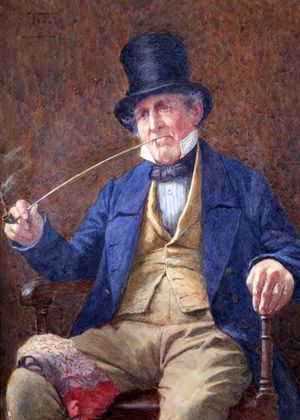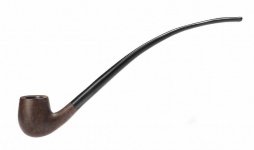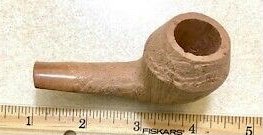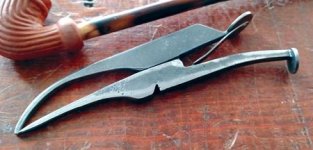One pipe shape everyone is familiar with is the Churchwarden. It’s instantly recognizable and makes a great wall piece in any pipe shop or man cave. They come in a variety of bowl shapes to fit all styles, but their commonality is the extra long stem. Your average churchwarden ranges between 16 to 18 inches and it’s a style of pipe most pipe smokers eventually try or own.
One might wonder where these pipes come from and how were they developed? As a professor of Pipeology, I decided to look into these fascinating pipes and try to uncover their origins. Ever since the Lord of the Rings was released in 2001 (yeah, it was that long ago that Frodo and the gang took us on the classic, if not some what disappointing departure from the book adventure), churchwardens have once again risen as a staple in the piping world. One might even think they are the invention from the mind of the great JRR Tolkien himself. This would not be true however and with even a modicum of thought, it’s easy to see this was a stylistic choice and not a practical one. No hobbit, wizard or dwarf would take a churchwarden on a quest. Given their extra-long length, they would be much more prone to breakage than the average pipe and after a long day of fighting Orcs and dragons, you would want to have a pipe with you that wouldn’t easily split in two. A pipe made of solid briar like Chris Morgan’s “One” would be a much more likely choice for any thinking hobbit or wizard.
You also might be tempted to think they were created to provide a cooler smoke. Due to myth, many think that the extra-long mouthpiece helps cool the smoke. Unfortunately, the mouthpiece would have to be 8 or 9 feet to really make any difference in the temperature of the smoke. Wikipedia has some insight on their genesis:
“Churchwarden pipes were reputedly named after churchwardens, or night watchmen of churches in the time that churches never locked their doors. These "churchwardens" could not be expected to go all night without a smoke, so they had pipes that were made with exceptionally long stems so the smoke and the pipe wouldn't be in their line of sight as they kept watch.”
How times have changed! I can tell you I’ve personally been kicked out of every church I ever tried to smoke a pipe in. I even got kicked out of a Presbyterian church while I was smoking Presbyterian mixture! While this explanation seems plausible, a simple bent pipe would keep the churchwarden’s line of sight equally as open. Plus, have you ever smoked a Churchwarden? They are kind of a pain in the ass. They are too long to be practical. They require extra-long pipe cleaners to clean them and clenching them is no pleasure. So I continued looking. Pipedia has a much more logical explanation:
“Back in the 1700 and 1800s, when pipe smoking was allowed in churches, is where this style of pipe began its life. Designed to rest on the back of church pews, the modern-day briar versions capture a piece of that history.
Churchwardens pipes were reputedly named after the Churchwardens who used to put their pipes long stem out of the church windows so they could smoke in church.”

Now we’re talking! I think enjoying a nice bowl of GH&Co Dark Bird’s Eye that was stuck out of the window of a church would make the service much more enjoyable (Especially when old Pastor Dave gets to prattling on about how we need lots of money to fix the churches aging pipe organ, which in the best of times sounds like the very gateway of hell opening. Seriously, have you heard a good song come out of one of these things in the past 50 years? Just let the thing die and let’s move on to modern instruments. If we’re are going to keep the damn thing, I know they aren’t church music, but just once can we hear a song that actually sounds decent on the organ like REO Speedwagon’s "Roll With the Changes" or Yes’s "I’ve Seen All Good People" instead of the cacophony of “please, for the love of God, someone put a spike into my temple and end all this for me” noise they usually play?). Wow, look at that, I nearly derailed my own post.
Anyways, I knew that couldn’t be the entire story behind the Churchwarden pipe so I dug into the history books. In my worldwide quest to find the answer, after hundred hours and expense, I uncovered some never-before-seen Louis Le Prince salvaged footage estimated to be from approximately 1880. Louis Le Prince was the true inventor of the motion picture, not that lying, elephant killing SOB Thomas Edison. (Yeah, as an American I hate to see the credit go to a Frenchman but he did get there first and he didn’t electrocute any elephants while they were alive just to try and beat the competition.)
As you can see in the footage, the inventor of the Churchwarden goes to that unsung hero of the pipe world - the fat guy. Fat guys are the cornerstone of the pipe world. They keep the pipe industry a float. Go to any pipe show and what will you see? Acres of fat guys. Some with old timey handlebar mustaches and suspenders. Fat guys, while often considered lazy, usually have an innate skill at finding the most efficient way to do things. Since they don’t like to get up and break a sweat, they’ll find a way to do something easier. Behind nearly every time saving invention is a fat guy. Who do you think invented the paint roller? No doubt a fat guy tired of standing and painting with a brush. Everyone knows Steve Wozniak, a fat guy, was the real brains behind Apple Computer. Ben Franklin, a fat guy, invented bifocals so he wouldn’t have to continuously take two pairs of glasses on and off to see near and far. The list goes on and on but I’m tired and a fat guy and want to wrap this up. The Churchwarden was invented by a fat guy because he didn’t want to get up every time something fell off his desk. He would just use his extra-long pipe as a grabber. When you think about it, the Churchwarden’s job was the ideal fat guy job of the age. It required sitting in a church for long periods of time just napping, reading, smoking and occasionally scaring away some teenage hoodlums from trying to get at the communion wine. And there we have it; the puzzle of the Churchwarden’s origins is definitively solved.
One might wonder where these pipes come from and how were they developed? As a professor of Pipeology, I decided to look into these fascinating pipes and try to uncover their origins. Ever since the Lord of the Rings was released in 2001 (yeah, it was that long ago that Frodo and the gang took us on the classic, if not some what disappointing departure from the book adventure), churchwardens have once again risen as a staple in the piping world. One might even think they are the invention from the mind of the great JRR Tolkien himself. This would not be true however and with even a modicum of thought, it’s easy to see this was a stylistic choice and not a practical one. No hobbit, wizard or dwarf would take a churchwarden on a quest. Given their extra-long length, they would be much more prone to breakage than the average pipe and after a long day of fighting Orcs and dragons, you would want to have a pipe with you that wouldn’t easily split in two. A pipe made of solid briar like Chris Morgan’s “One” would be a much more likely choice for any thinking hobbit or wizard.
You also might be tempted to think they were created to provide a cooler smoke. Due to myth, many think that the extra-long mouthpiece helps cool the smoke. Unfortunately, the mouthpiece would have to be 8 or 9 feet to really make any difference in the temperature of the smoke. Wikipedia has some insight on their genesis:
“Churchwarden pipes were reputedly named after churchwardens, or night watchmen of churches in the time that churches never locked their doors. These "churchwardens" could not be expected to go all night without a smoke, so they had pipes that were made with exceptionally long stems so the smoke and the pipe wouldn't be in their line of sight as they kept watch.”
How times have changed! I can tell you I’ve personally been kicked out of every church I ever tried to smoke a pipe in. I even got kicked out of a Presbyterian church while I was smoking Presbyterian mixture! While this explanation seems plausible, a simple bent pipe would keep the churchwarden’s line of sight equally as open. Plus, have you ever smoked a Churchwarden? They are kind of a pain in the ass. They are too long to be practical. They require extra-long pipe cleaners to clean them and clenching them is no pleasure. So I continued looking. Pipedia has a much more logical explanation:
“Back in the 1700 and 1800s, when pipe smoking was allowed in churches, is where this style of pipe began its life. Designed to rest on the back of church pews, the modern-day briar versions capture a piece of that history.
Churchwardens pipes were reputedly named after the Churchwardens who used to put their pipes long stem out of the church windows so they could smoke in church.”

Now we’re talking! I think enjoying a nice bowl of GH&Co Dark Bird’s Eye that was stuck out of the window of a church would make the service much more enjoyable (Especially when old Pastor Dave gets to prattling on about how we need lots of money to fix the churches aging pipe organ, which in the best of times sounds like the very gateway of hell opening. Seriously, have you heard a good song come out of one of these things in the past 50 years? Just let the thing die and let’s move on to modern instruments. If we’re are going to keep the damn thing, I know they aren’t church music, but just once can we hear a song that actually sounds decent on the organ like REO Speedwagon’s "Roll With the Changes" or Yes’s "I’ve Seen All Good People" instead of the cacophony of “please, for the love of God, someone put a spike into my temple and end all this for me” noise they usually play?). Wow, look at that, I nearly derailed my own post.
Anyways, I knew that couldn’t be the entire story behind the Churchwarden pipe so I dug into the history books. In my worldwide quest to find the answer, after hundred hours and expense, I uncovered some never-before-seen Louis Le Prince salvaged footage estimated to be from approximately 1880. Louis Le Prince was the true inventor of the motion picture, not that lying, elephant killing SOB Thomas Edison. (Yeah, as an American I hate to see the credit go to a Frenchman but he did get there first and he didn’t electrocute any elephants while they were alive just to try and beat the competition.)
As you can see in the footage, the inventor of the Churchwarden goes to that unsung hero of the pipe world - the fat guy. Fat guys are the cornerstone of the pipe world. They keep the pipe industry a float. Go to any pipe show and what will you see? Acres of fat guys. Some with old timey handlebar mustaches and suspenders. Fat guys, while often considered lazy, usually have an innate skill at finding the most efficient way to do things. Since they don’t like to get up and break a sweat, they’ll find a way to do something easier. Behind nearly every time saving invention is a fat guy. Who do you think invented the paint roller? No doubt a fat guy tired of standing and painting with a brush. Everyone knows Steve Wozniak, a fat guy, was the real brains behind Apple Computer. Ben Franklin, a fat guy, invented bifocals so he wouldn’t have to continuously take two pairs of glasses on and off to see near and far. The list goes on and on but I’m tired and a fat guy and want to wrap this up. The Churchwarden was invented by a fat guy because he didn’t want to get up every time something fell off his desk. He would just use his extra-long pipe as a grabber. When you think about it, the Churchwarden’s job was the ideal fat guy job of the age. It required sitting in a church for long periods of time just napping, reading, smoking and occasionally scaring away some teenage hoodlums from trying to get at the communion wine. And there we have it; the puzzle of the Churchwarden’s origins is definitively solved.
Last edited:









